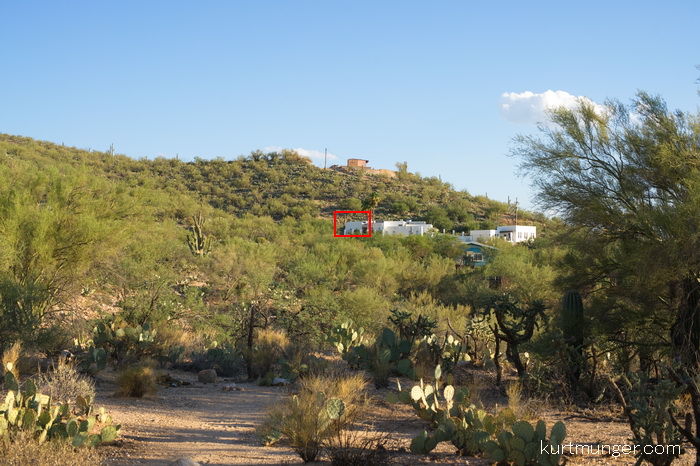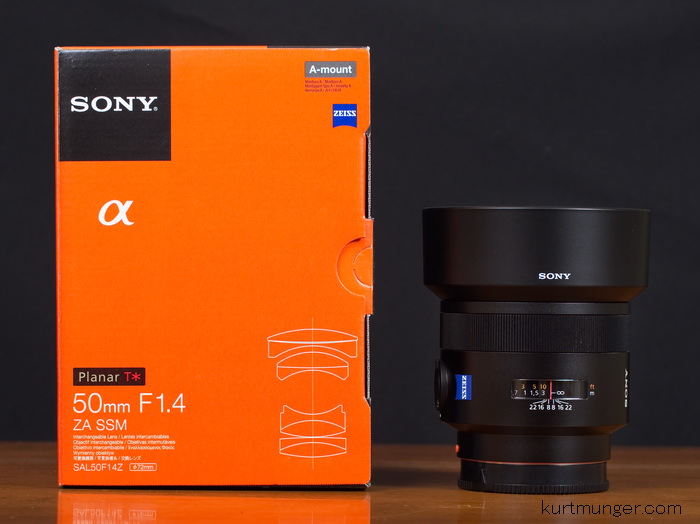 |
| Box and contents |
The Sony A77 and A900 were used for this review. For a better understanding of terms and methods used in this review, go here. The usual center, mid-section and corner crops are located at the very bottom of the page.
Introduction.
The full frame coverage Sony Carl Zeiss 50/1.4 Planar T* SSM lens was introduced in late 2012, and became widely available in mid-to-late 2013; it’s an all new design using 8 elements in 5 groups, with SSM. Sony and Minolta users have been patiently waiting for an upgraded fast 50mm lens for quite some time. The Minolta designed Sony 50/1.4 lens goes back to 1985, and received a few upgrades in coatings, aperture and outer design through the years, but the actual optical design (7 elements in 6 groups) I think goes back even farther to 1979 with the manual focus Minolta 50/1.4 MD Rokkor-X. The Sony 50/1.4 was a good lens back in the day, but at wide apertures it is soft, and not up to 21st century standards in my opinion, even the Sigma 50/1.4 HSM is superior at wide apertures. Found on the outside of the lens is an AF/MF switch, and focus hold button, which can be changed to DOF on certain camera bodies. Also, normal on prime lenses from Sony is a focus distance scale under a clear plastic window with depth of field hash marks. The Sony CZ 50mm F/1.4 has an aluminum body, and of course the distinctly smooth CZ metal mount. Build quality is very good, with a nice fit and finish, and it feels solid in the hand, it’s very similar in size and weight to the CZ 85/1.4. Sony says the lens is ‘dust and drip’ resistant, but the question here is how many ‘drips’ is it going to take to void the warranty? I hear Sony is good about reasonable repairs under warranty, so maybe I’m a bit over cautious. The lens body has an appealing black paint finish, similar to other Sony Carl Zeiss prime lenses. Filter size is 72mm, which is used on many of Sony’s primes, like the 85/1.4, 24/2, 20/2.8 etc, see full list in the summery. Sony claims the use of 2 aspherical, and 1 ED glass element in the design of the lens, although that is slightly ambiguous when reading Sony’s description of the lens on their website. In keeping with the newer mirrorless lens designs, Sony has installed the aperture blades in the reverse, meaning the tips of the blades are showing through the front element, it’s usually the other way around. The lens says ‘made in Japan’.
In the box is the lens, front and rear caps, a cheap plastic solid hood* (ALC-SH126), inspection card signed by the world famous H. Hirano(?), and owner’s manual. *Note, for $1500, this lens should have a good metal hood with black flannel inside, not what looks like a Vivitar replacement hood with spray painted black undercoating on the inside.
Focusing. The manual focusing ring is damped a tiny bit too much in my opinion, and is hard to turn with one finger, but It doesn’t “wander” when jiggling the camera. Focus ring travel is 1/4 of a turn form close-up to infinity, which is a good amount of travel, and allows precise focusing, but will depend on your focusing ability and eye sight.
AF; This lens uses a focusing motor inside the body, called SSM or Super sonic wave motor.” SSM is almost silent, and pretty fast, and it’s better than Sony’s cheap SAM system. With SSM, you can over-ride the AF system by simply turning the manual focus ring after the AF locks.
When using F/1.4-2 at closer focusing distances I had to adjust the AF system for a persistent slight mis-focus, thankfully, it was resolved with a -6 micro adjustment with the A900, however, you may, or may not have to adjust your copy. Longer focusing distances were perfect, even at F/1.4.
Requisite product shots.
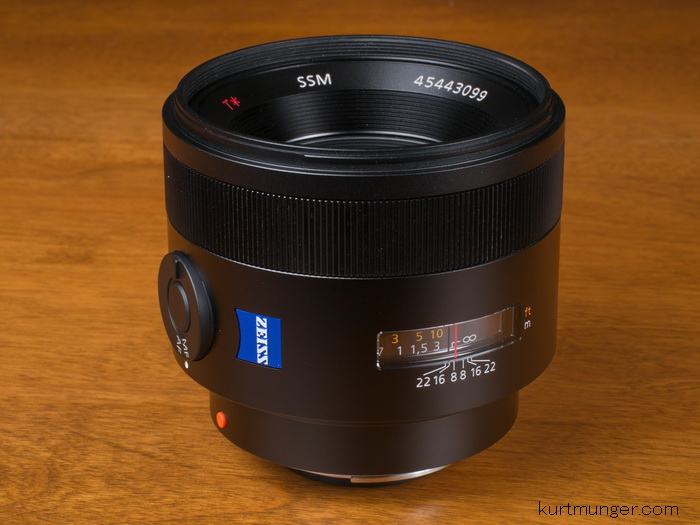 |
| Side shot showing AF/MF switch, focus hold button, and bold ‘Zeiss’ logo. |
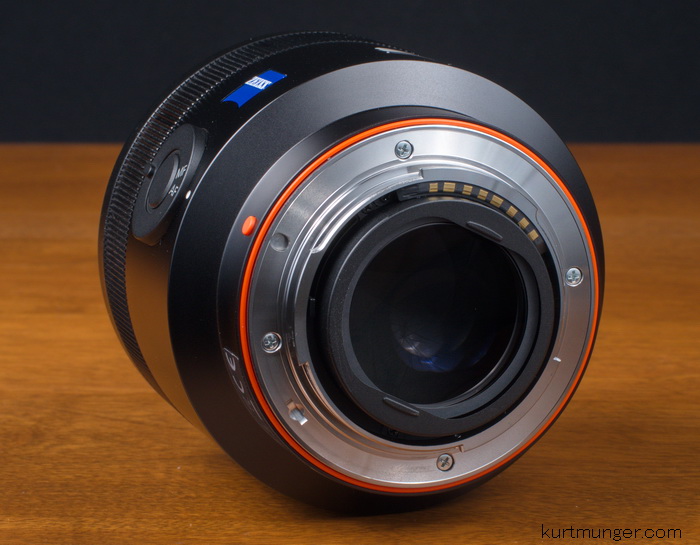 |
| Back side showing very smooth machined Zeiss metal mount. |
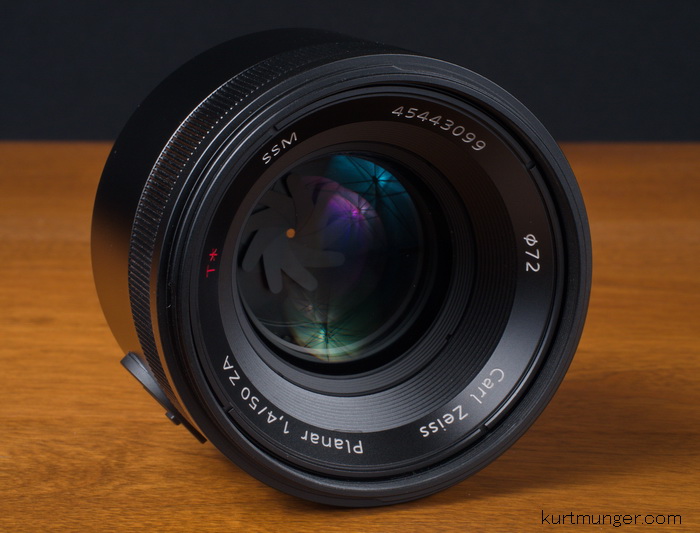 |
| Deep set front element. |
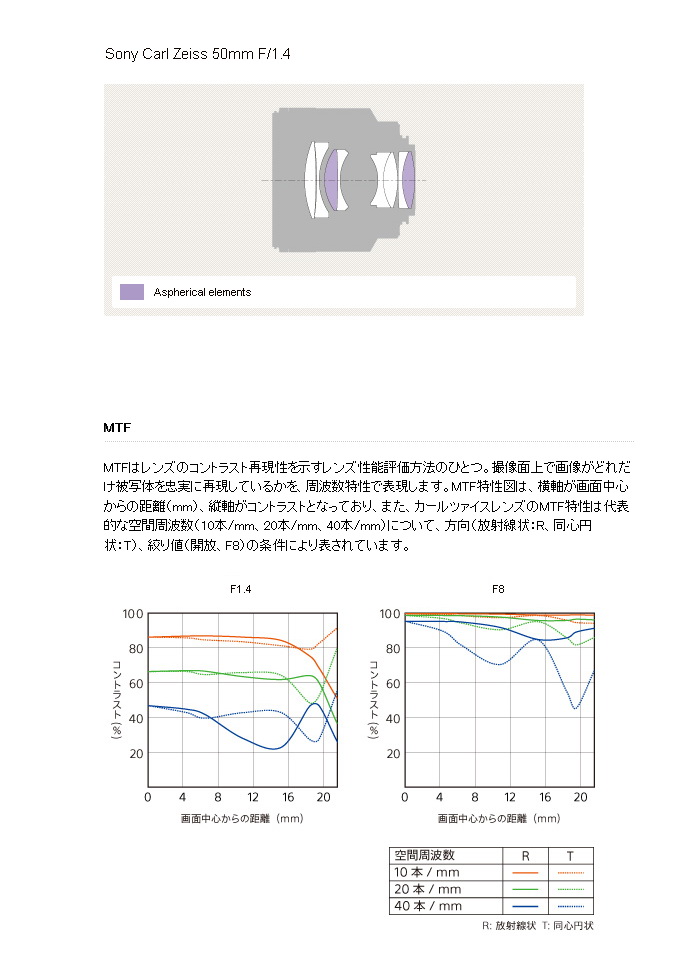 |
| Sony X-ray view and incomplete MTF chart |
General information and specifications.
|
Lens
|
|
|
Box contents
|
Front cap, rear cap, cheap plastic hood, and users manual.
|
|
Cost
|
|
|
Build quality
|
Very good.
|
|
Additional information
|
|
|
Specifications below
|
|
|
Optical configuration
|
8 elements in 5 groups
|
|
Angle of view
|
47˚ full frame, 32˚ APS-C
|
|
Aperture
|
9 blades, curved
|
|
Full frame and APS-C
|
Made for full frame, but works fine on APS-C cameras.
|
|
Depth of field and focus scales?
|
Depth of field hash marks, and focus distance scale in window.
|
|
Minimum focus, image plane to subject
|
17.4″ (442mm)
|
|
Minimum focus, end of lens barrel to subject
|
12.6″ (320mm)
|
|
Hard stop at infinity focus?
|
No.
|
|
Length changes when focusing?
|
No.
|
|
Focus ring turns in AF?
|
No.
|
|
Filter size
|
72mm.
|
|
Filter ring rotates?
|
No
|
|
Distance encoder?
|
Yes
|
|
Max magnification
|
0.14x or 1:7.1
|
|
Min. F/stop
|
F/22
|
|
Sony teleconverter compatible?
|
No
|
|
Length changes when zooming?
|
N/A
|
|
Dimensions WxL (my measurements)
|
2.8″ x 3.2″ 71mm x 81mm.
|
|
Maximum extended length (my measurements)
|
3.2″ (81mm)
|
|
Weight bare (my scale)
|
18.2oz (516g) bare.
|
Optical qualities summary.
Lens flare/ghosting. Above average control. I see some small green blobs when the sun is directly inside the image in bright situations, but almost none otherwise.
Light fall-off. Somewhat heavy on full frame wide open, and low on APS-C. See samples below.
Color fringing (CA). Lateral color fringing control is above average and hardly noticeable. You see some axial color fringing also when the aperture is wide open, but it clears up mostly by F/2.8-4, see crops in the full frame section.
Bokeh. Smooth, see examples below.
Color. The same as other Sony lenses.
Close up filter. N/A
Coma. A tiny amount noticeable in the far corners at F/1.4; samples in FF section.
Regular filters cause no additional light fall-off problems using APS-C or full frame cameras.
Filter size. 72mm. Other Sony lenses to use this size are the: 20/2.8, CZ 24/2, CZ 85/1.4, 135 STF, and the 16-50mm F/2.8.
Distortion. Barrel type; minor on APS-C, moderate on Full frame.
 |
| Very mild barrel distortion on APS-C. |
Distortion is mild using an APS-C camera.
Light fall-off samples, (APS-C).
Light fall-off is very light and not a problem, even at F/1.4 with a filter attached.
|
F/1.4
|
F/2
|
|
|
 |
|
F/2.8
|
F/4
|
 |
|
Bokeh in the center area looks smooth at all apertures, however, I see some spherochromatism at F/1.4-2.8, which causes that particular aperture bokeh to appear less smooth than at other apertures. Spherochromatism shows itself as colored tinges around blurred highlights, such as when the foreground is blurred, you’ll get red outlined highlights, with the background blurred, you’ll get green outlined highlights, this goes away as you stop down, and is mostly noticeable on fast lenses when used wide open. Bokeh along the sides of the frame is harsh at wide apertures, but that’s typical for this type of lens. Distance to in-focus subject; about 7′ (2.1m) with the background about 16′ (5m) away. The A900 was used for these images, I put them here as this is the normal place for Bokeh samples, and I’m too lazy to add anther crop table in the full frame section.
Axial color fringing occurs all over the image, but goes away as you stop down the aperture. The stadium lights show some magenta fringes, but it goes away around F/4. This is not a big deal as you can remove this issue in photoshop lightroom newer versions under ‘Chromatic aberrations’ and then ‘defringe’.
Maximum reproduction size.
Check out the cropped image of the stamp. The sample shot was taken with the Sony A77 24MP camera. The subject is a standard US stamp, 0.87″x 1.0″ or 22mm x 25mm. Also, note the macro shot was taken as close to the subject as focusing allowed; in this case 12.6″ (320mm), measured from the front of the lens barrel to the subject.
This lens has an approximate reproduction size of 0.14x (1:7.1) which is about average for this type of lens, and it turned in a sharp image of the stamp. The stamp shot is displayed full size, but cropped. As a side note; the “1996” on the bottom left of the stamp measures a mere 1mm wide.
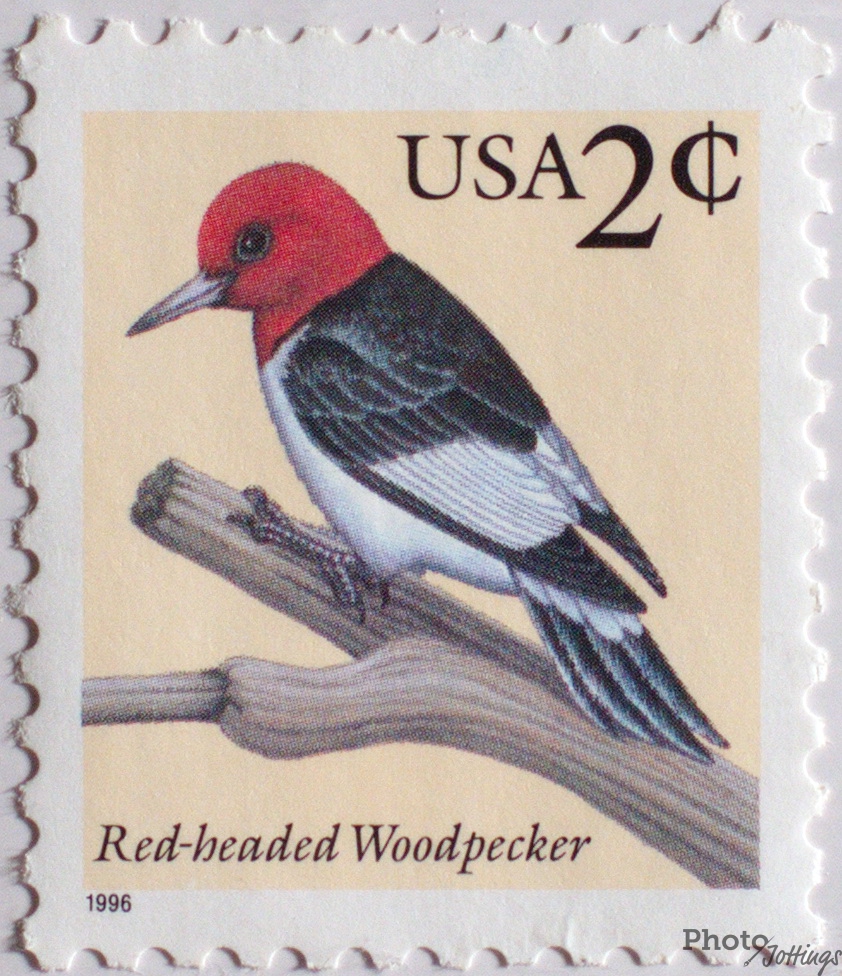 |
| As close as you can get, F/7.1. Click for larger image. |
_______________________________________________________________________
Full frame results using the Sony A900 below.
Check out the differences when using a film or full frame camera below. I’m only pointing out the noticeable issues as compared to the APS-C bodies, so if I don’t show it here, the results are not significantly different enough to warrant posting an additional set of images in this section.
Light fall-off
There is definitely more light fall-off using a full frame camera, with noticeably dark corners and mid-sections at F/1.4, but it clears up nicely by closing the aperture one or two stops. Using a regular “thick” type filter produces little to no additional light fall-off.
Flare and ghosting.
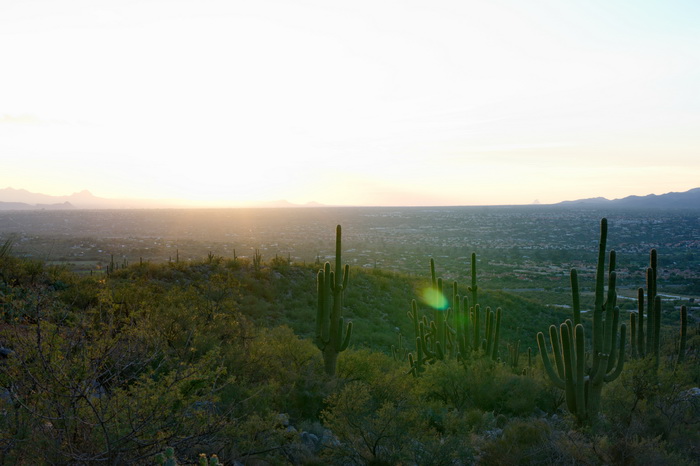
Ghosting is kept to a minimum, with only some green blobs visible, and contrast holds up well when the sun is directly inside the image. This is as bad as I could make it look in a real picture, even over-exposed as this one is. If I waved the lens around in the sun at high noon you may see a little more ghosting.
Lateral color fringing.
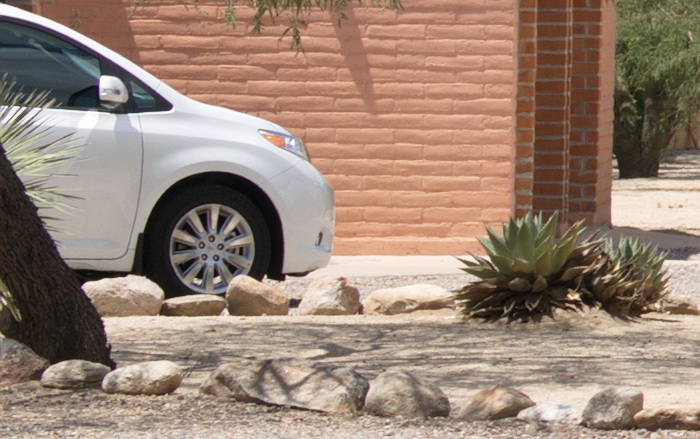
Technically, there is a hint of color fringing, (magenta) along the tree trunk sides, but in real use, there is none visible. This 100% crop was taken at the last 700 pixels from the left side.
Coma sometimes shows up in the corners of fast (F/1.4-2.8) wide to medium length lenses, and takes the forms of birds, bats, or jets! The CZ 50/1.4 SSM has fairly mild coma at F/1.4-2, and almost nothing stopped down farther. This performace is much better than the original Sony 50/1.4 lens. For really bad coma see this review. Crop is of a small Christmas tree at the very corner of the image, about 25′ (7.6m) away.
Full frame distortion.
 |
| Mild to moderate barrel distortion on full frame. |
I see some moderate barrel distortion with full frame coverage, (although the curve looks simple); it’s almost completely repairable in post processing.
Conclusion.
The Sony Carl Zeiss 50/1.4 SSM is very well built, with fast and accurate SSM focusing, excellent resolution even with the aperture wide open, and way above average control of lateral color fringing and Coma. A couple of minor negatives as compared to the Sigma is the Zeiss has more light fall-off and more axial color fringing at wide apertures like F/1.4-2, and of course the price of the Zeiss is over three times that of the Sigma. However, the Zeiss equals or excels in all other areas, so it’s worth a little more right? But how much more, especially when you look at the current price of full frame offerings from Canon, and Nikon; and by ‘current’ I mean recently designed 50mm, F/1.4, (or this faster one for about the same price). One might successfully argue that the Sony CZ 50/1.4 is built better, and possibly has better performance at very wide apertures, unfortunately, I don’t have any other 50/1.4 lenses to make any direct comparisons, but I can make some educated guesses between the lenses I’ve reviewed, so here goes……
Sony 50/1.4. Lagging way behind both lenses below in resolution at F/1.4-4, and coma at F/1.4-2.8. Probably close in all around performance at F/5.6 on down.
Sigma 50/1.4 HSM. Resolution about the same as Zeiss at all apertures. Coma stronger at F/1.4-2 than Zeiss. Flare and ghosting control not as good, build quality good, but not like the Zeiss. No focus hold button.
Carl Zeiss 50/1.4 SSM. Build quality the best by far. Coma control the best. Bokeh smoother than Sigma, about the same as the Sony. Flare and ghosting control better than Sigma, about the same as Sony, focusing slightly faster and more accurate than Sigma, about the same as the Sony, (your results may vary depending on camera used). Light fall-off stronger than Sigma, and axial color fringing stronger at F/1.4-2.
Which one is best for…?
Landscapers that won’t be using any aperture below F/5.6: the old Sony 50/1.4 is just fine, plus, it’s smaller and much less expensive than the Zeiss. Stopped down resolution differences are probably not noticeable unless flipping back and forth between images at 100%. The Sigma is generally less expensive than a new Sony, so if you don’t mind the extra bulk and weight, I’d go with the Sigma 50/1.4 HSM.
Low light hand held street shooting: the Sigma will be adequate, but watch the focusing, depth of field is slim at F/1.4, so focusing is crucial, and the Sigma AF system is not always as reliable and accurate as Sony; meaning one sample may be right on, another will be way off. People that don’t want to gamble with potential quality issues from Sigma should spring for the Zeiss.
Budget conscious people looking for resolution only; the Sigma is by far is the best choice, assuming you get a copy similar to the one I reviewed.
APS-C users; I’d go for the 35/1.8, it’s the same basic coverage, and works very well. Based on optical performance, it’s a much better bargain that the Zeiss. Also, contrary to popular belief, using the Zeiss on an APS-C camera actually degrades the performance as the full frame sides are actually slightly sharper than at the mid-sections where the APS-C sides would be.
Is it really worth $1500? When you compare it with the Sigma, probably not, but when compared to the older Sony 50/1.4 it is a very welcome upgrade, and if you’re using a full frame Sony camera, it’s the only high quality choice you have.
|
